Whether you’re contemplating a complete house rewire or simply having a socket moved, there’s a high likelihood that the walls will need to be chased in order to get the cables to their new destinations. The process is a messy one, and doesn’t require any real specialist skill set, so it’s no surprise customers often ask if we will be carrying out the chasing work ourselves.
This guide sets out to explain everything a homeowner needs to know about chasing walls including whether or not you should ask the electrician to do it!
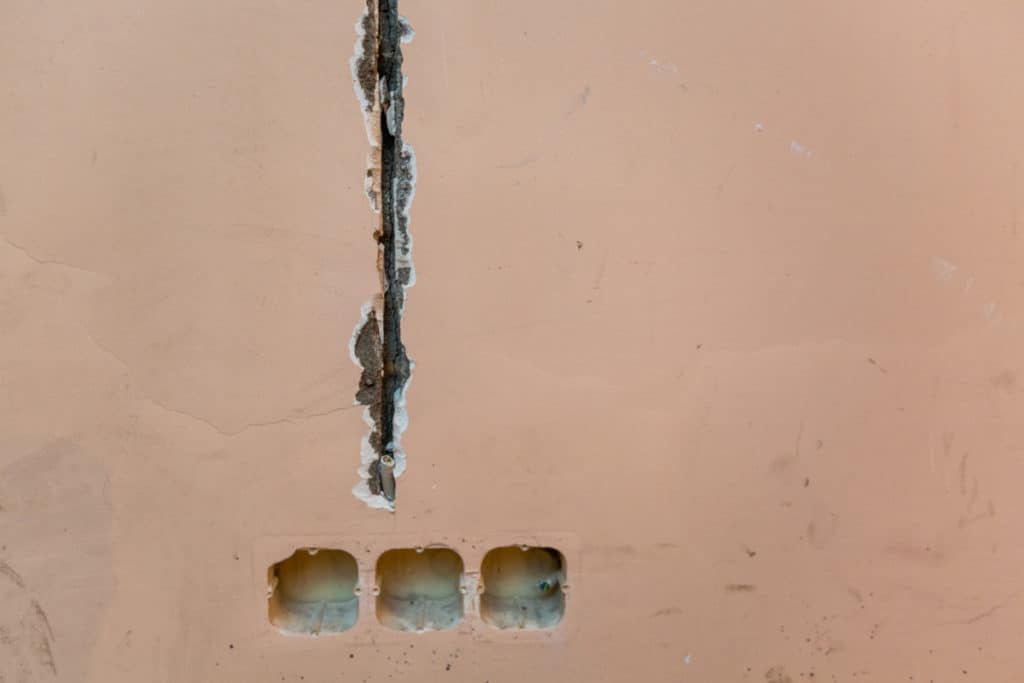
Electricians regularly chase walls but homeowners and other trades people can do the task for them. As the position of the wall chases are governed by wiring regulations, many electricians prefer to do the task themselves in order to ensure compliance.
So electricians will chase walls but it kind of depends on the size of the project. If it’s a small job like a new socket then it makes economical sense for the electrician to do the chase themselves whilst they are doing the rest of the work.
In other larger projects this isn’t always the case, In my career I’ve done several rewires of council owned vacant properties. For these buildings that are undergoing major refurbishment work, it makes financial sense for the council to employ labourers (at a cheaper hourly rate than electricians) to carry out the wall chasing, using chasing machines similar to this one on Amazon.
If you’re a homeowner, the idea of chasing out a wall yourself may seem like an ok job, and a good way to keep costs down. The rest of this guide will hopefully help steer you in the right direction, so we’ll start at step one.
What is Wall Chase?
A wall chase is the name given to the process of cutting and chiselling out channels in a wall to allow electricians to run their cables in. Once the cables are in, and the work is finished, the chases can be refilled and decorated so the cables are now concealed in the wall.
As you look around the room you’re in you’ll see sockets low down in the wall. The cables that give power to those sockets are most likely buried in the wall. Although this is a lot of work and mess at the time, the finished and decorated walls look a lot nicer than some of the alternatives. (I’ll talk about some of the alternatives at the end)
Do Stud or Plasterboard Walls get Chased?
We do not chase out plasterboard walls to run electrical cables in. Instead we are able to run the cables in the cavity in-between the wall. If you knock on the wall and hear a hollow sound, chances are that this is a stud wall with a cavity in the middle which is perfect for cables.
This does not mean that this type work will be completely mess free. If there are wooden supports in the wall running horizontally, and the electrician needs to get the cables down the wall vertically, some drilling of the wooden supports need to be done.
If you’ve ever heard an electrician say they are “fishing” the cable down the wall, they mean they are trying to get the cable down the wall and catch it at the bottom. Like fishing this process can get a little frustrating as we can’t see the cable so it can be a little tricky.
How Do We Protect Electrical Wires in a Wall?
The two main methods electricians use for protecting cables that are buried in the wall are the use of conduit systems and placing the cables in safe zones as prescribed by the wiring regulations. There are different types of conduit systems offering different levels of protection.
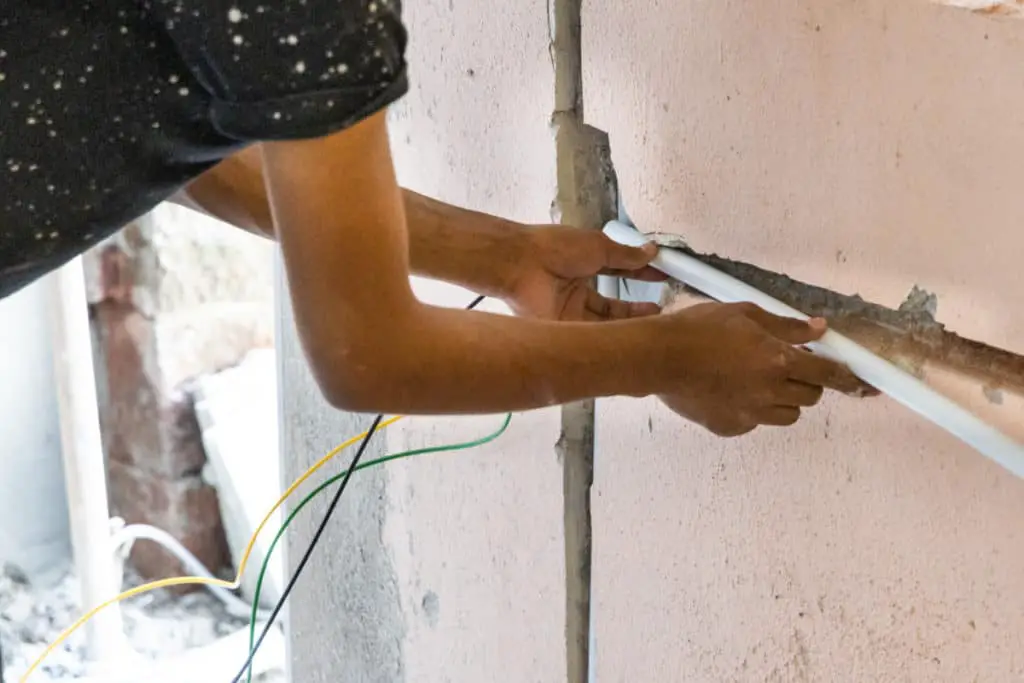
Conduit refers to the hollow tubing that electricians use to run cables in. It affords some protection to the cables although it’s not designed to resist impact (such as drilling into the wall!)
We rely on the safe zones that we place the cables in to ensure others don’t drill the wall where the cables are concealed!
The main types of protection used in chased walls are
- PVC oval shaped conduit. This has the advantage as its oval of being shallower so the chases don’t need to be so deep. This is a very common type of protection used but being plastic it won’t stop a drill or a nail!
- Metal round conduit. This is more industrial, being metal it offers more protection and used to be the go to solution many years ago. However the cost of materials and time implications to install make this rarely used in domestic properties today. Another problem is that being round requires deeper chases which may then not meet new building regulations (more details later)
- Plastic capping. It is possible to bury a cable directly against the masonry and then put a capping over the top. This capping is very thin and affords no real protection to the cable but helps the plastering as we don’t then have to plaster directly onto the cable when we’re done.
Re-plastering after electrical work is a whole topic in itself. If you’d like to learn more about what you can expect an electrician to do in this regard you can read it here.
Do Cables in Walls Need Capping?
Whilst researching for this article I discovered that it is possible to plaster directly onto cables without capping. However, in my opinion as an electrician, it is a very bad idea to leave a cable so exposed to a plasterer’s trowel. The cost and time it takes to add some capping is very minimal.
If the cable where to get damaged, the wall would have to be chased back out again to replace the damaged length of cable. I can’t see why it’s worth taking the risk in my opinion.
How Do We Chase a Wall?
If a homeowner wants to do the chasing themselves they should have a discussion with the electrician carrying out the work. They may be more than happy to let you do it and if so will mark out the safe zones on the wall so the homeowner knows exactly where to chase!
We must avoid a situation like the one pictured below! No electrician could run their cables in that chase as they would be breaking the wiring regulations (at least in the UK regulations) and be liable to prosecution in the event of an accident.
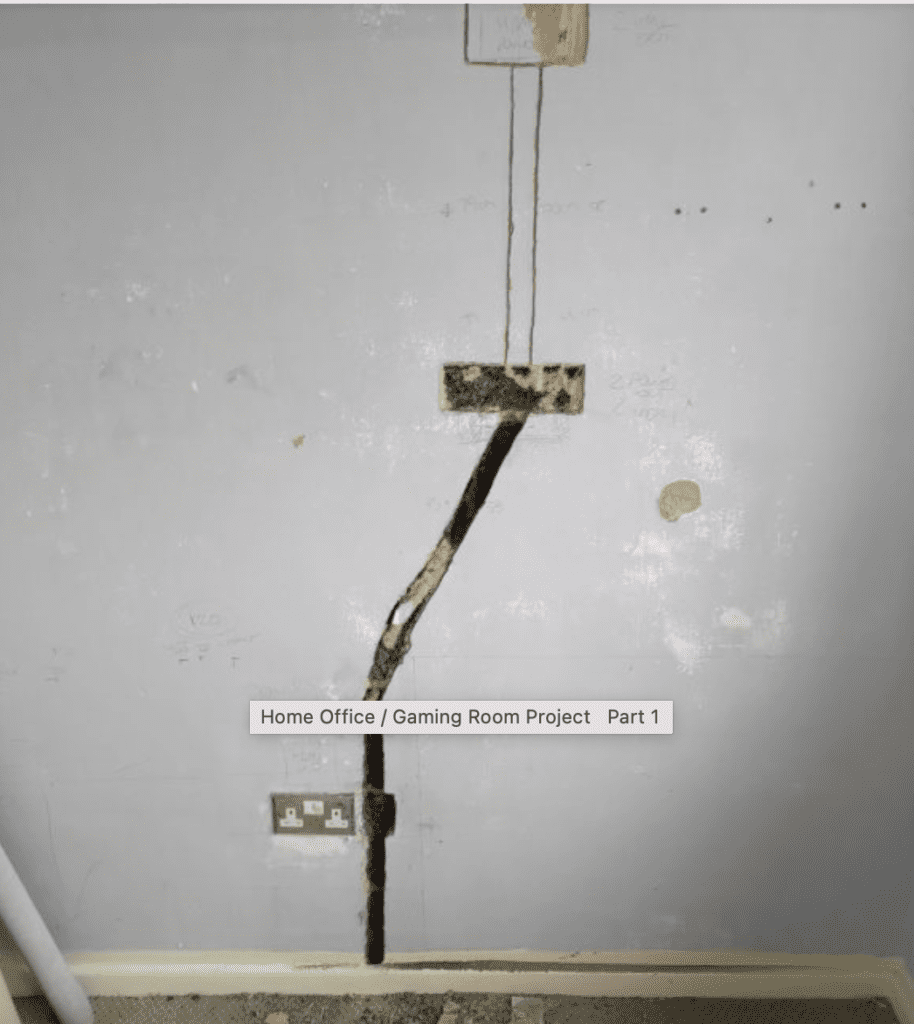
Once that chase has been refilled and painted over how could anyone else know there are live electric cables hidden in the wall there? Photo source
I don’t mean to sound like I’m on my high horse but when it comes to electricity safety is the number one factor. I’ve had the situation before where the homeowner has done their own thing chasing walls without asking and I’m left to explain that their hard work was in vain.
The process of chasing involves either using a chasing tool like this one on Amazon (would defo recommend using a tool, see further down the post) or an old fashioned hammer and chisel only. We cut lines in the wall deep enough for the cables, any conduit system and enough extra depth to re-plaster afterwards.
How Deep Should a Wall Chase Be?
The depth of a wall chase is governed by the building regulations in Approved Document A Section 2c. It states that vertical wall chases should be no deeper than 1/3 the thickness of the leaf and that horizontal chases be no deeper than 1/6 of the thickness of the leaf of the wall.
The document also states that chases should not be so positioned as to impair the stability of the wall. Building regulations (document link here) stipulating these measurements are designed to maintain the stability of the wall.
There are also other regulations such as not having chases back to back, so it’s definitely worth checking with an expert before beginning work.
If we chased the wall so deep that we were nearly through to the other side I don’t think the wall would be very safe and stable afterwards!
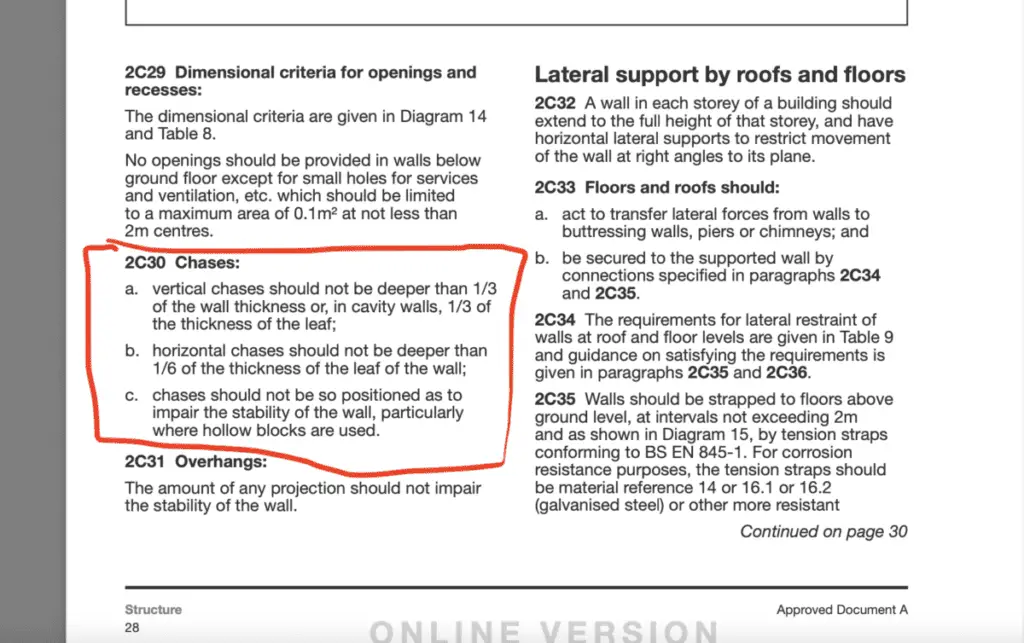
The leaf of a wall basically means the thickness of the wall. Many homes are made up of double-leaf masonry (an inner and outer wall tied together via wall ties and insulation placed in the gap) Source.
Best Tool for Chasing a Wall
The best tool for chasing a wall is the unoriginally-named: Wall Chaser. It is a powered tool, fitted with a dust extraction that allow the user to cut channels into a wall. The tool can be set so that an even depth which complies with the building regulations is maintained.
A chisel and hammer is then required to simply remove the middle masonry which usually falls out pretty easily.
These tools can be hired for around £60 a week (plus around a £200 deposit) from tool hire companies such as hirebase. Alternatively if we need one for longer than a week or we think we’ll use it again it can be better value to purchase one from retailers such as B&Q or online.
Even with a wall chaser, the right chisel and a good hammer to then remove the brickwork will make the world of difference and save lots of headaches (I’ll link to one on Amazon here).
Don’t forget PPE such as gloves, goggles and dust mask (See on Amazon). Chasing walls is a task that can be very dangerous if done wrong, the chaser has two fast spinning cutting blades, so the correct PPE and taking care is vital!
One of the best tools you can use for chasing walls is to get someone else to do the messy and noisy job for you!
An electrician colleague’s unique ‘banter’ when asked the best tool for chasing
Cost Estimates To Chase a Wall
If the electrician is required to chase the walls, the cost will be built into the price of the quote. At an average cost of around £250 a day for an electrician, the cost of chasing can add up quickly, especially on major projects such as rewires requiring several days to complete the chases.
If a homeowner chooses to chase the walls the cost is limited to the hire or purchase of the chasing machine, hammer chisel and the PPE required. The biggest cost to the homeowner is their time. If they enjoy some hands on DIY, chasing walls may be a project they actually enjoy that also saves them money.
When trying to cut costs a homeowner may consider avoiding the expense of the chasing machine. If it is just one chase then maybe there is some logic to this. However, in my experience once you have a little go at chasing a wall with just a hammer and chisel you’ll be running of to the shop to but the chaser in no time!
How Do You Fill In a Chased Wall?
A chased wall will be filled with the conduit system and cable chosen by the electrician. This will then be plastered over either by the electrician, a plasterer or the homeowner. Before work begins, be sure everyone is clear on who is responsible for filling in and redecorating the wall afterwards.
The article I wrote regarding do electricians plaster walls after chasing goes into a lot more detail regarding making good to the walls after electrical work.
It’s worth a read (if I do say so myself) as this is an area I’ve seen homeowners get caught out. They assumed the electrician was going to do the repair whilst the electrician assumed the customer would. Better to sort these bits out before work begins.
The Alternatives to Chasing Walls
There are several alternative wiring methods available to electricians to prevent them having to chase walls. These included systems such as surface mounted conduit or trunking as well as clipping the cable directly onto the wall. Each method is most suited to different environments.
Unfortunately, non of these methods are perfect for domestic properties which is why everyone still goes through the mess and disruption of chasing walls!
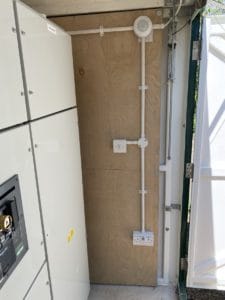
Surface mounted trunking is an option for residential properties where chasing the walls isn’t suitable. It is quick and easy to fix to the wall and allows easy access to the cables again if need.
From a practical standpoint surface mounted plastic trunking is far easier to install and maintain the cables. However, the downside is that it doesn’t look very nice in a domestic setting and most homeowners don’t want this in their property.
Surface mounted conduit. This method is often used in commercial buildings, for example in a warehouse. Aesthetics are often not as important in commercial settings such as these, and it allows easy access to the cables in the event of needing a repair.
Clipping cables direct can be a good choice depending on the location and type of cable. SWA cable is great for being attached directly to a wall using cable clips if running outside (for example along an outside wall to an outdoor socket). The steel wire armour on the cable protects it from the elements, vermin damage and some level of mechanical protection (ie being hit).
Hopefully that’s covered everything we need to know about chasing walls. Don’t forget to check building regulations and chat to an electrician before starting any work!
